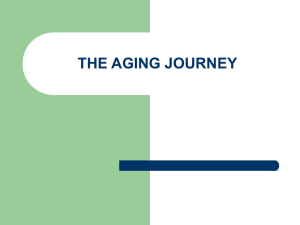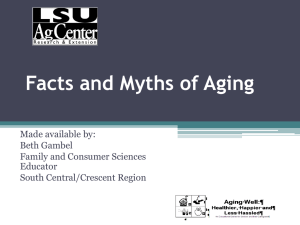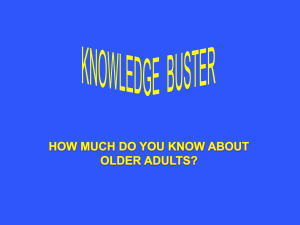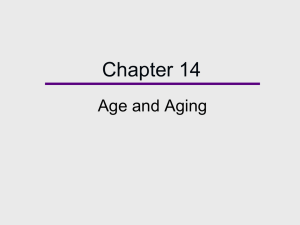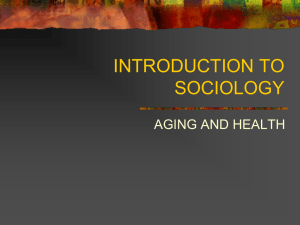Communication and Aging Chp. 2 Attitudes and Ageism Chelsea
advertisement
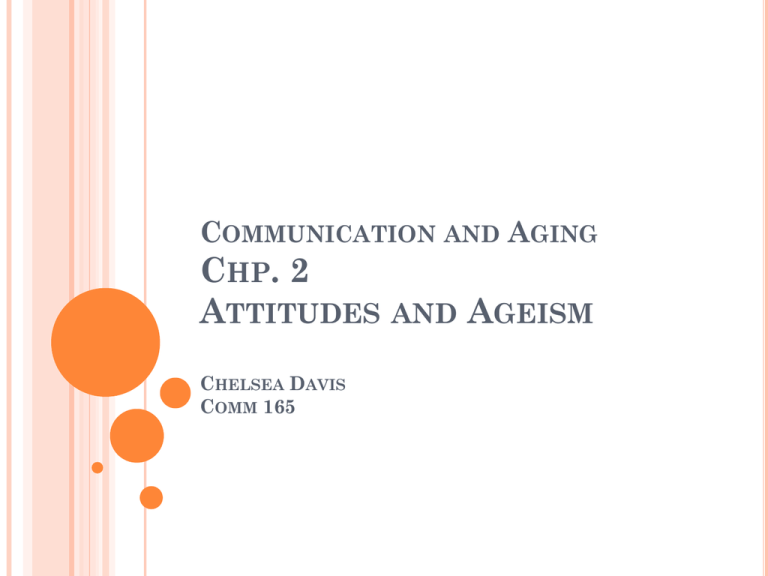
COMMUNICATION AND AGING CHP. 2 ATTITUDES AND AGEISM CHELSEA DAVIS COMM 165 VIEWS OF AGING PROCESS The difference between the way young adults view elderly people and the way elderly view themselves well over 200 empirical studies. The majority showed negative attitudes towards the aging process. The United States is based off of a Greek culture so the negative attitudes are a direct result of that VIEWS OF AGING PROCESS Greek Very negative Stressed the great fortune of youth and the great fortune of youth and the misfortune of the old An individual who dies young is loved by the gods. A person who lives into old age is being punished by the gods Middle Eastern Very positive “Age brings status and prestige to a man not only in his family but also in his community Old age is a blessing, and, therefore if a person dies young, that individual is not blessed RESEARCH TRENDS IN AGING STUDIES 1) Relative to ratings of other age categories, ratings of old age tend to be more negative 2) Most people have mixed feelings about various aspects of old age and tend to rate old age positively on some dimensions and negatively on others 3) There are more stereotypes associated with old age than with younger ones 4) Many negative stereotypes are held by a majority of people 5) Knowledge about aging can be improved and misconceptions can be reduced by training in gerontology, but attitudes are more resistant to change. COMMON STEREOTYPES Negative Severely impaired Despondednt Shrew/ curmudgeon recluse Postive Golden ager Perfect grandparent John Wayne conservative WHAT ACTIVATES A GIVEN STEREOTYPE Context Characteristics of the perceiver Characteristics of the elderly individual CONTEXT Activating either a positive or negative stereotypes by making positive or negative aspects of aging salient in the encounter Example- meeting an older person in a nursing home would make the negative aspects of aging more salient Example 2- Meeting the same older person on a cruise ship would make the positive aspects of aging more salient CHARACTERISTICS OF THE PERCIEVER Influence whether positive or negative stereotypes are activated An individuals cognitive complexity and quality of prior contact with the elderly people influence the schema he or she has available to be activated. CHARACTERISTICS OF THE ELDERLY Characteristics of the elderly individual will influence which stereotypes are activated If the older person exhibits traits that are related to negative stereotypes those will be activated with same with positive stereotypes The more a younger individual encounters an elderly in a positive or negative situation is how the person is going to perceive the elder COMMUNICATION ACCOMMODATION THEORY Individuals define their social identity through the groups to which they belong. Individuals compare their own group’s status in society to that of other groups, finding ways to bolster their self esteem by identifying the positive aspects of their own group. Theory has been applied to aging by indentifying that one categorization made by individuals is whether or not the other person is a age peer or a member of a different age group Individuals identified as members of “old age” because of negative stereotypes of aging are placed in an undesirable position and find that others diverge from them Summarized by the Communication Predicament of Aging COMMUNICATION PREDICAMENT OF AGING Proposes a spiraling effect of aging-related expectations, conversational experiences, and future expectations for interaction. Older individuals are believed to have difficulty with both receptive and expressive communicative skills. Lead younger person to modify and accommodate their difficulties. UNCERTAINTY REDUCTION THEORY First, as the social distance between individuals decreases, young people may be less likely to enter interaction with the elderly Second important implication involves the greater importance of level of income over age when young people are asked about their willingness to interact with an “old person” “MONEY EQUALS POWER” CONCLUSION Attitudes are likes and dislikes, which often lead to prejudice and discrimination Recent investigations have explored that attitudes to the aging process are becoming more positive, but still predominantly negative These attitudes have led to an ageist society
